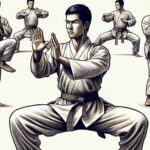Introduction
Table of Contents
Show jumping is an exciting equestrian sport where horse and rider must navigate a series of obstacles in a timed course. This sport tests the agility, speed, and coordination of both horse and rider. But have you ever wondered how many obstacles are used in a show jumping course? In this article, we’ll explore the different types of obstacles, the typical number of obstacles in a course, and what each obstacle is designed to test. This guide is tailored to be informative, easy to understand, and will help young readers gain a better understanding of the thrilling world of show jumping.

Understanding Show Jumping
Show jumping is a popular sport that takes place in an arena with a series of obstacles arranged in a course. The main objective is to complete the course with the fewest faults, which can be earned by knocking down poles, refusing to jump, or exceeding the time limit.
What is an Obstacle in Show Jumping?
An obstacle in show jumping is a structure that the horse must jump over. These obstacles are usually made of poles that are balanced on stands, which can be knocked down if the horse doesn’t clear them correctly. Obstacles can vary in height and width, providing different levels of difficulty.
Types of Obstacles in Show Jumping
There are several types of obstacles used in show jumping, each designed to test different skills:
1. Vertical
A vertical is a simple jump that consists of poles or planks placed one above the other. This type of obstacle tests the horse’s ability to jump high without knocking down the poles.
2. Oxer
An oxer is a wider jump made of two verticals close together, creating a spread. It can be square, ascending, or descending. Oxers test both the height and width of the horse’s jump.
3. Combination
A combination consists of two or more jumps set close together, usually requiring one or two strides between them. This tests the horse’s agility and the rider’s control over their stride length.
4. Water Jump
The water jump is a spread obstacle with a body of water underneath. It tests the horse’s ability to jump long distances and the rider’s ability to guide the horse confidently over the obstacle.
5. Triple Bar
A triple bar is a spread jump with three elements of ascending heights. This obstacle tests both the horse’s strength and its ability to judge distances.
6. Wall
A wall is an obstacle that looks like a solid wall but is usually made of lightweight blocks that can fall if hit. This tests the horse’s bravery and ability to jump solid-looking objects.
How Many Obstacles Are There in a Show Jumping Course?
The number of obstacles in a show jumping course can vary depending on the level of competition and the size of the arena. Typically, a show jumping course consists of 8 to 16 obstacles. For higher levels of competition, like the Olympics or World Championships, the course might include the maximum number of obstacles, challenging even the most skilled riders and horses.
Factors Affecting the Number of Obstacles
- Level of Competition: Lower levels may have fewer obstacles, while advanced levels may have the maximum number of obstacles allowed.
- Arena Size: A larger arena can accommodate more obstacles, allowing for more complex courses.
- Course Designer: The course designer’s creativity plays a significant role in determining the number of obstacles and how they are arranged.
Designing a Show Jumping Course
Designing a show jumping course is an art that requires knowledge of the sport, an understanding of horse and rider capabilities, and creativity. The course designer must create a course that is challenging but fair, ensuring that it tests various skills without being overly difficult.
Course Layout
The layout of a show jumping course is crucial. Obstacles are placed in such a way that they challenge the horse and rider to maintain a steady rhythm, make quick turns, and adjust stride lengths.
Importance of Balance in a Course
A well-balanced course includes a mix of verticals, oxers, and combinations. This balance ensures that the course is challenging and tests a wide range of skills.
Common Show Jumping Course Strategies
Riders often have different strategies when approaching a show jumping course. Understanding the course and planning how to tackle each obstacle is key to success.
1. Walking the Course
Before the competition, riders are allowed to walk the course. This helps them understand the distances between obstacles, plan their approaches, and decide where they need to speed up or slow down.
2. Adjusting Strides
Adjusting the horse’s strides between obstacles is crucial. Longer strides might be needed for wide oxers, while shorter strides are important for tight combinations.
3. Keeping a Rhythm
Maintaining a steady rhythm throughout the course helps the horse stay balanced and focused, reducing the risk of faults.

Table of Information
| Obstacle Type | Description | Purpose |
|---|---|---|
| Vertical | Simple vertical poles | Tests height clearance |
| Oxer | Two verticals close together | Tests width and height clearance |
| Combination | Two or more jumps close together | Tests agility and control |
| Water Jump | Spread jump with water beneath | Tests long jump capability |
| Triple Bar | Spread jump with three ascending elements | Tests strength and distance judgment |
| Wall | Solid-looking obstacle | Tests bravery and jumping solid objects |
Conclusion
Show jumping is a fascinating sport that combines speed, agility, and precision. The number of obstacles in a show jumping course can vary, but each course is designed to test different skills in both horse and rider. Understanding the different types of obstacles and how they are used in a course can help riders prepare better and enjoy the sport more. Whether you’re new to show jumping or an experienced rider, knowing the ins and outs of the obstacles and course design can make a big difference in your performance.
FAQs
1. How many obstacles are usually in a show jumping course?
A show jumping course typically includes 8 to 16 obstacles, depending on the level of competition and the size of the arena.
2. What is the most difficult obstacle in show jumping?
The difficulty of an obstacle can vary depending on the horse and rider, but water jumps and combinations are often considered among the most challenging.
3. How high are the jumps in show jumping?
The height of jumps can range from 2 feet (0.6 meters) for lower levels to over 5 feet (1.5 meters) in advanced competitions.
4. Can a horse refuse to jump an obstacle?
Yes, a horse can refuse to jump an obstacle, which results in a fault. Multiple refusals can lead to disqualification.
5. What is a fault in show jumping?
A fault in show jumping occurs when a horse knocks down a pole, refuses a jump, or exceeds the time limit. Faults add penalties to the rider’s score.


